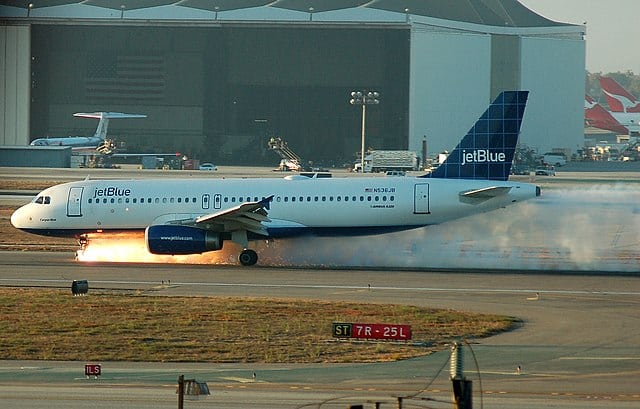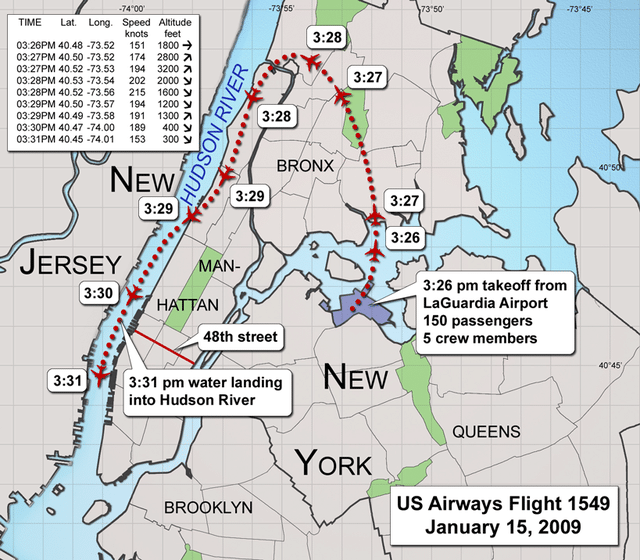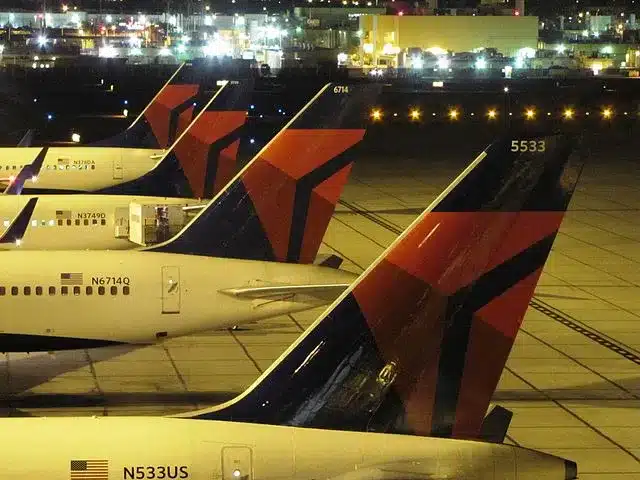Aircraft Emergency Landings - Why do they happen?
An Emergency Landing refers to the immediate landing (or ditching) of an aircraft – either on or off an airport – due to unforeseen events. Or actions.
Causes range from technical: engine failure, adverse weather conditions and landing gear malfunctions to the non-technical: Passengers (and their baggage) and security threats.
Interested in more? Great, we looked at the key emergency landings in 2023. And we compiled a report you might find…grounding.
| Airline | Date | Airport | Problem | Flight | Aircraft |
|---|---|---|---|---|---|
| Delta Airlines | 06.29.2023 | Charlotte | Landing Gear | DL1092 | B717 |
| Air India | 06.07.2023 | Magadan (Russia) | Engine Issue | AI173 | B777 |
| Ryanair | 04.09.2023 | Liverpool | Landing Gear | FR5542 | B737 |
| Turkish Airlines | 06.11.2023 | Budapest | Passenger illness | TK003 | A330 |
| JetBlue | 06.30.2023 | Syracuse | Engine Issue | B62030 | A321 |
| Spirit Airlines | 03.01.2023 | Jacksonville | Passenger Device Fire | NK259 | A320 |
| United Airlines | 03.07.2023 | San Diego | Passenger Device Fire | UA2664 | B737 |
| Lufthansa | 03.02.2023 | Washington | Severe Turbulence | LH469 | A330 |
| Asiana | 05.26.2023 | Daegu | Unruly Passenger | OZ8129 | A321 |
| Easyjet | 04.21.2023 | Faro | Pilot illness | EZ6469 | A320 |
| United Airlines | 03.29.2023 | Houston | Engine Issue | UA129 | B767 |
| Jetstar | 01.07.2023 | Chubu | Bomb Threat | GK501 | A320 |
| American Airlines | 02.23.2023 | Raleigh-Durham | Unruly Passenger | AA3444 | ERJ145 |
| Aer Lingus | 04.13.2023 | Dublin | Birdstrike | EI123 | A330 |
| Cargolux | 05.15.2023 | Luxembourg | Landing Gear | CV6847 | B747F |
| Tarom | 03.24.2023 | Istanbul | Bomb Threat | RO154 | B737 |
| Qantas | 01.18.2023 | Sydney | Engine Issue | QF144 | B737 |
We share this data not to identify airlines, or aircraft or engine types as part of a search to find causes and cures. No. Our report reveals what we already knew – that a tiny minority of flights declare an emergency for a variety of reasons.
An important point of note : When you see technical issues such as “Engine” or “Landing Gear” this does not mean engine failure or landing gear failure. It (much more often) means the cockpit crew didn’t like a warning/alert. And decided to put safety first.

3 Types of Emergency Landings
Forced Landing
A forced landing occurs when an aircraft needs to land immediately, either on an airport or off it, due to the inability to continue the flight. This situation often arises from factors like engine failure, where the pilot has no choice but to land the plane promptly.
Precautionary Landing
A precautionary landing is a planned landing, either on or off an airport, when it is deemed unwise to continue the flight. Various conditions can warrant a precautionary landing, such as worsening weather conditions, becoming lost, running low on fuel, or experiencing gradual engine issues. In these cases, the pilot chooses to land as a precautionary measure, ensuring everyone’s safety.
Ditching
Ditching is forced landing on water. When circumstances make it necessary, such as an in-flight emergency over a body of water, the pilot will intentionally land the aircraft on the water’s surface. This maneuver requires specific procedures and preparations to maximize the chances of survival.
Approach for Landing
A precautionary landing is considered less dangerous than a forced landing because it provides the pilot with more time to assess the situation and plan the approach carefully. It allows for runway selection and the opportunity to make adjustments using engine power to compensate for errors in control issues.
What can happen, especially in the general aviation space, is a pilot without instrument rating who becomes trapped in unfavorable weather conditions. As tragically happened in the Kobe Bryant accident. Or when a pilot fails to consider the possibility of a precautionary landing despite imminent fuel exhaustion.
Now. We know what you really want to know…
Oh yes we do.
That JetBlue A320. Or that United B737Max… in a pinch – could I land it?
Theoretically, Yes.
In reality – in a real emergency – nope. But let’s see how you might do it.

Pass the FAA Private Pilot test with flying colors. Achieve your dreams of flying an airplane.
You can Fly! - How to Land a Plane
Autoland is an advanced feature that assists pilots in landing an aircraft automatically, particularly in challenging conditions. While a passenger could not directly engage the Autoland function, understanding the process can provide insight into emergency landings. First, let’s explain what Autoland is :
Autoland systems, such as Category IIIB Autoland, Global Navigation Satellite System (GNSS) Landing System, Integrated Approach Navigation, and Navigation Performance Scales, work together or independently to enhance safety, performance, and cost-efficiency.
Autoland Systems:
- The Category IIIB Autoland system provides all-weather, precision autopilot guidance for certain aircraft models like the B737 and A320.
- The GNSS Landing System (GLS) utilizes GPS navigation satellites and a Ground-Based Augmentation System (GBAS) to guide the aircraft to the runway, potentially replacing the Instrument Landing System (ILS).
- Integrated Approach Navigation (IAN) offers ILS-like pilot procedures, display features, and autopilot control laws for non-precision approaches.
- Navigation Performance Scales (NPS) integrates lateral and vertical navigation with actual and required navigation performance, providing valuable information to monitor flight path performance.
Forced Landing
Before we go any further : As a passenger, in theory, you could do this. But in reality you would not have access to the cockpit or instructions on how to engage the Autoland function. During an emergency landing, your job is to follow the instructions and guidance of the flight crew and cabin crew. They are trained professionals who will handle the situation and make decisions in the best interest of everyone’s safety.
Is there an emergency Autoland?
Yes there is.
Commercial Aircraft have what is known as CAT III Autoland systems and all modern aircraft such as the B737 and A320 have it. What’s interesting is the rollout phase after landing. This requires the pilot to take over and stop the aircraft manually. And no – its not a big red button that a hero passenger can see and press inside the cockpit. But it can be done if you know how.
Here’s the (very!) basic steps.
1. The Pilot (or you) decides that the Autoland will be engaged. So first, he programs everything into the FMS (Flight Management System). This gives the aircraft the airport and runway radio aid information and engages the autopilot and autothrust systems.
2. Autoland takes over and provides the inputs for the flight controls on approach. It also adjusts the power inputs to maintain glide slope and directional heading.
3. Some systems require that the pilot reduce the throttle controls to IDLE when performing Autoland.
4. On Touchdown the pilots must select thrust REVERSERS. And once the wheels touchdown Autoland will disengage and the pilot takes over.
5. If there’s a problem (weather, technical snafu) the pilot can take over at any time. Autoland can also perform a go-around with the autopilot engaged.
Emergency Descent
For the General Aviation Community, technology has come to the rescue. Garmin, one of the leaders in GPS and Flight Technology have Autonomi – a system designed to not only return an aircraft to an airfield and land – it takes care of all of the actions along the way. Such as notifying Air Traffic Control and picking the safest route. Here’s a quick explainer video.

In an emergency situation, the most crucial action for passengers is to remain calm. Follow crew instructions, and trust in the expertise of the flight crew to ensure a safe landing.
Familiarize yourself with emergency procedures provided by the airline and pay attention to the safety briefing before each flight.
And remember – there’s a special place in hell for anyone who even thinks about grabbing a cabin bag during an evacuation.
Passengers Evacuating with their Cabin Baggage
It’s not unusual for passengers to bring their cabin luggage with them during an evacuation. In its Occurrence Report on the disaster that occurred in Calgary in 1984, the Canadian Aviation Safety Board (CASB) noted that “many (passengers) stopped to retrieve hand baggage before they left (evacuated).”
This tendency is getting worse and could get worse because airlines are allowing more luggage to be carried into passenger cabins. Recent advances in smartphone technology have resulted in a rise in photographic evidence of travelers bringing their luggage with them during emergency evacuations.
Some operators now charge customers to check “hold” baggage in an effort to shorten turnaround times by encouraging more and more carry-on luggage. If cabin luggage is determined to be too large during the check-in/boarding procedure and must be transferred to the hold, expensive fees may be assessed.
Passengers frequently try to take their cabin baggage with them during an evacuation because of the value of its contents, which includes valuables and essentials like passports, legal and business documents, electronic equipment, medicines, and more. This is especially true if it’s all they have with them or where they packed their valuables.

Get yourself in the sky today and feel what it’s like to be a pilot!
Accidents where passengers evacuated with cabin baggage include:
Air France A340-300 Toronto, Canada 2 August 2005
Virgin Atlantic A330-300 London Gatwick, UK 16 April 2012
Asiana Airlines B777-200 San Francisco, USA 6 July 2013
Air Canada A320-200 Halifax, Canada 29 March 2015
British Airways B777-200 Las Vegas, USA 8 September 2015
Emirates B777-300 Dubai, Emirates 3 August 2016
American Airlines B767-300 Chicago, USA 28 October 2016
How Common are Emergency Landings?
Our 2023 study shows an emergency landing in the order of once every 3-4 days on commercial aircraft worldwide. So, far more common than we would like however the reasons for these deviations make sense when you look at the causes from our grid above.
One Direction Causes
What are some causes for emergency Landings?. Well, the accident data we have directly correlates. If an aircraft (engine or system) no longer functions, if a pilot loses control (LOC I).
Types of emergency landings
- Bird strike
- Cabin or Cockpit window Failure
- Runway Closure
- Fuel Exhaustion
- Landing Gear Failure
- Dumping Fuel
Threat Management - the most common in 2023 accidents
- Adverse weather condition – A factor in 31% of accidents. Weather conditions were cited as a contributing factor (18% of the accidents) including wind, wind shear, sever gusts and thunderstorms.
- Aircraft malfunction was cited in 21% of the accidents. This was mostly engine related.
- Failure in the landing Gear was cited in 15% of the accidents. That includes structures (pylons, hydraulics) as well as brakes and tires.
- Non-Compliance to Standard Operating Procedures (SOPs) contributed to 26% of accidents. As well as manual handling and flight control errors which contributed to 21% of the accidents.
- Abrupt Aircraft Control and Vertical, Lateral or Speed Deviations – These contributed to 15% of accidents. Followed by Unstable Approaches and long landings (13% of the accidents).
- Inadequate management decisions (including regulatory decisions) contributed to 10% of the accidents. Deficiencies in maintenance operations was also cited in 10% of the accidents.
- Overall Crew Performance and lack of monitoring and crossing checking contributed to 13% of accidents. In flight Decision-making contributed to 11% of the accidents

Emergency Landing on Water
We have the greatest case study for this with Captain Sully Sullenberger and the Miracle on the Hudson. Initially criticized for failing to get back to a New York airport, the accident report quickly recognized the genius, skill and composure Sully showed that day.
His US Airways Airbus A320 was involved in one such incident without any fatalities on January 15, 2009. It struck a flock of Canada Geese shortly after takeoff at La Guardia, New York, and both engines completely lost thrust. Sully decided to make a water landing in the Hudson River after determining that no runway could be reached before the jet perished. All 150 passengers, Sully and his co-pilot, and three flight attendants successfully evacuated after the controlled ditching in water.
Obviously, a water ditching differs significantly from a land evacuation. One of the most significant distinctions is the absence of emergency exits in a ditching since some may be below or near the waterline and may not be recognized as ditching exits by certification criteria. All of the upper deck evacuation slides on the Airbus A380 function as slide-rafts.
Life rafts may need to be launched through Type III or Type IV emergency exits for some airplanes, and the cabin crew should be in charge of such operations.

Unruly Passenger Flights
Every hour, hundreds of passengers take flights without incident. But sometimes, a tiny minority decide that being a normal human being is not for them. Some are drunk. Some succumb to the stresses of flying. This type of inflight emergency is unacceptable and the crew on board are not paid to deal with your shit.
Cabin Battleground
Airlines, governments, and our fellow travelers are becoming increasingly concerned about the number and seriousness of unruly passenger events. And incidents involving assaults on crew and other passengers. This harassment and disregard for safety puts us all in jeopardy.
Unruly incidents, which are committed only by a small percentage of passengers, have a disproportionately negative effect. We have a whole article on it and while these acts frequently go unpunished because of gaps in the current international air law, that’s changing in the US and in the EU.
Air Transat Flight 236 - The World Record
We have an article on “How Airplanes Fly” and we dedicated a large portion of it on Captain Piche and their entirely unintended record of being glider pilots of an A330 for 20+ minutes.
Sustaining only minor damage, they discovered to their surprise/horror at their normal flight altitude that they did not have adequate fuel to reach their destination. Not only that, the only attractive landing site was the only landing site in the middle of one of the largest bodies of water on the planet. They landed in the azores with minor damage. But the airplane damage was minor compared to the damage Capt Piche did to his mini bar when he got to his hotel room.
Passenger Device Battery Fire
Lithium Ion batteries (in your laptop and your phone and your iPad) are allowed in the cabin. They are also allowed in the cockpit, in the form of EFBs (Electronic Flight Bags). Pilots use electronic devices to minimize paperwork and to better connect airline data.
How airlines deal with In-flight Battery Fires
The use of traditional firefighting techniques and fire extinguishing equipment in order to put out a lithium battery fire is ineffective. Halon can put out open flames, but it can’t deal with the fire’s origin. The ideal method to enable cooling and prevent spread to nearby cells is to use water. When a lithium battery cell catches fire, the focus must be on quickly cooling the surrounding cells with water (or another non-alcoholic liquid) and preventing the situation from getting worse in order to prevent the fire from spreading to the nearby battery cells.
Safety Procedures
Isolating the source of the fire is the first step in responding to a lithium battery fire in the cabin. In fact, due to the highly exothermic thermal runaway, a smoldering battery could explode at any moment.
Do not pick up or attempt to move any burning or smoke-emitting object inside the cabin.
Make sure there are no combustible substances (fluids, gases, or equipment) next to the smoldering battery to prevent propagation. Passengers should be moved away from any heated or burning equipment as well.
Use precise techniques to put out the fire.
After isolating the burning or heating apparatus, attention must be given to the fire itself. In order to accomplish this, three distinct cabin crew procedures to handle fires caused by lithium batteries have been devised based on FAA recommendations.







